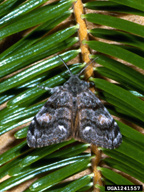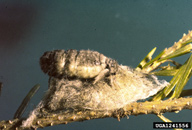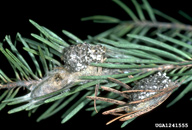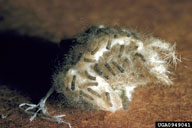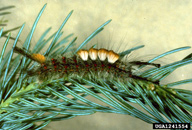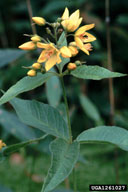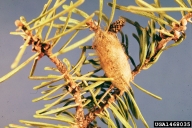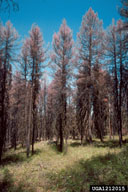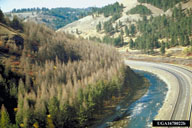Douglas-fir tussock moth
Orgyia pseudotsugata (McDunnough) (Lepidoptera: Lymantriidae)
Orientation to pest
The Douglas-fir tussock moth, Orgyia pseudotsugata (McDunnough), is a native defoliator of major importance in the interior Douglas-fir and true fir forests of western North America, where is defoliates Douglas-fir (Pseudotsuga menziesii) and various true firs (Abies). Adults emerge in late summer or early fall. The flightless females remain on their cocoons, where they mate and lay their egg mass. Eggs overwinter and hatch the following spring when new foliage has appeared. Young larvae crawl to new needles and begin feeding, but small larvae may disperse by dropping on silken threads and being blown by the wind, especially when new foliage is not available. Young larvae feed on the unfolding new needles, while older larvae feed on both new and old foliage. Foliage of heavily infested forest stands turns distinctly brownish. By late summer, mature larvae form cocoons either on the foliage when densities are low or on tree trunks and objects on the ground when densities are high. New adults emerge in a few weeks to complete the life cycle. The cocoons and egg masses are among the most conspicuous evidence of tussock moth abundance. There is one generation a year. Periodic large scale outbreaks have occurred. These outbreaks develop explosively but subside abruptly after about 3 years. Between outbreaks this insect is seldom seen.
Hosts commonly attacked
Douglas-fir tussock moth feeds on Douglas-fir (Pseudotsuga menziesii), and various native firs, especially grand (Abies grandis [Douglas ex D. Don] Lindley), white (Abies concolor [Gordon] Lindley ex Hildebrand), and subalpine fir (Abies lasiocarpa [Hooker] Nuttal).
Distribution
Douglas-fir tussock moth is found from southern British Columbia through the eastern half of the Pacific coast states. It is also found in the Rocky Mountain States, south to Arizona and New Mexico.
Images of Douglas-fir tussock moth
| Figure 1. Adults of Douglas-fir tussock moth, Orgyia pseudotsugata: left, male; right, wingless female on her cocoon | Figure 2. Egg masses (left) of Douglas-fir tussock moth and egg mass (right) with newly hatched larvae |
| Figure 3. Mature larvae of Douglas-fir tussock moth | Figure 4. Cocoons of Douglas-fir tussock moth (right), and close up (left) |
| Figure 5. Feeding damage of Douglas-fir tussock moth on Douglas-fir trees | Figure 6. Defoliation and tree mortality caused by Douglas-fir tussock moth |
Important biological control agents related to this pest species
The Douglas-fir tussock moth has many natural enemies including a nucleopolyhedrosis virus that is capable of dramatically reducing populations, but which usually appears after trees have been seriously defoliated. Many parasitoids are known to attack this species, including a Telonomus sp. egg parasitoid, and the larval parasitoids Phobocampe pallipes (Provancher) (Ichneumonidae) and Carcelia yalensis Sellers (Tachinidae). Parasitoids sometimes hasten the decline of an outbreak.
Web links for information on Douglas-fir tussock moth
- Fact Sheet from IPPC | Oregon State University
- Fact Sheet and Management Guide from FETCH 21 | University of British Columbia
- Forest Health Note | Washington State University Cooperative Extension
- Forest Insect & Disease Leaflet 86 | USDA Forest Service
Articles
- Mills, N. J. and F. Schoenberg. 1985. Possibilities for the biological control of the Douglas-fir tussock moth, Orgyia pseudotsugata (Lymantriidae), in Canada, using natural enemies from Europe. Biocontrol News and Information 6 (1): 7-18.
- Dahlsten, D. L., D. L. Rowney, and W. A. Copper. 1992. Comparison of artificial pupation shelters and other monitoring methods for endemic populations of Douglas-fir tussock moth, Orgyia pseudotsugata (McDunnough) (Lepidoptera: Lymantriidae). The Canadian Entomologist 124: 359-369.
- Otvos, I. S., R. F. Shepherd, and J. C. Cunningham. 2001. Orgyia pseudotsugata (McDunnough), Douglas-fir tussock moth (Lepidoptera: Lymantriidae), pp. 204-212. In: Mason, P. G. and J. T. Huber (eds.). Biological Control Programmes in Canada, 1981-2000. CABI Publishing, Wallingford, UK.
- Otvos, I. S. and R. F. Shepherd. 1991. Integration of early virus treatment with a pheromone detection system to control Douglas-fir tussock moth, Orgyia pseudotsugata (Lepidoptera: Lymantriidae), populations at pre-outbreak levels. Forest Ecology and Management 39: 143-151.
